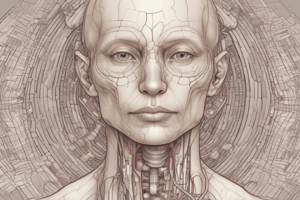Podcast
Questions and Answers
What complication may occur due to excessive thyroid tissue removal during thyroidectomy?
What complication may occur due to excessive thyroid tissue removal during thyroidectomy?
- Hypoparathyroidism
- Hypothyroidism (correct)
- Thyrotoxic crisis
- Bleeding due to slipped ligature
What serious condition can occur in a thyrotoxic patient who is not properly prepared for thyroid surgery?
What serious condition can occur in a thyrotoxic patient who is not properly prepared for thyroid surgery?
- Hypoparathyroidism
- Thyrotoxic crisis (correct)
- Respiratory obstruction
- Laryngeal nerve paralysis
Which of the following is an emergency treatment for a patient suffering from bilateral recurrent laryngeal nerve paralysis after thyroid surgery?
Which of the following is an emergency treatment for a patient suffering from bilateral recurrent laryngeal nerve paralysis after thyroid surgery?
- O2 therapy and IV fluids
- Calcium and vitamin D3 supplementation
- Carbimazole administration
- Emergency tracheostomy (correct)
Which medication is NOT typically used in the treatment of a thyrotoxic crisis?
Which medication is NOT typically used in the treatment of a thyrotoxic crisis?
What is the primary cause of hypoparathyroidism that may occur after thyroid surgery?
What is the primary cause of hypoparathyroidism that may occur after thyroid surgery?
What are the primary hormones secreted by the follicular cells of the thyroid gland?
What are the primary hormones secreted by the follicular cells of the thyroid gland?
Which hormone is considered the active and fast-acting component of thyroid function?
Which hormone is considered the active and fast-acting component of thyroid function?
What condition is defined as the enlargement of the thyroid gland?
What condition is defined as the enlargement of the thyroid gland?
In which condition are thyroid hormone levels increased while TSH levels are low?
In which condition are thyroid hormone levels increased while TSH levels are low?
How can goitre be prevented according to the provided information?
How can goitre be prevented according to the provided information?
Which type of goitre occurs due to physiological demands for thyroid hormones during puberty and pregnancy?
Which type of goitre occurs due to physiological demands for thyroid hormones during puberty and pregnancy?
What is the influence of thyroid stimulating hormone (TSH) on the secretion of T3 and T4?
What is the influence of thyroid stimulating hormone (TSH) on the secretion of T3 and T4?
What is the commonest type of goitre according to classification based on shape?
What is the commonest type of goitre according to classification based on shape?
Which symptom is associated with hyperthyroidism?
Which symptom is associated with hyperthyroidism?
What is the primary treatment for hypothyroidism?
What is the primary treatment for hypothyroidism?
Which of the following is NOT an indication for thyroidectomy?
Which of the following is NOT an indication for thyroidectomy?
What condition is characterized by bradycardia and hypotension?
What condition is characterized by bradycardia and hypotension?
What diagnostic test assesses vocal cord mobility before thyroid surgery?
What diagnostic test assesses vocal cord mobility before thyroid surgery?
Which drug is commonly used to treat tachycardia in hyperthyroid patients?
Which drug is commonly used to treat tachycardia in hyperthyroid patients?
Which type of thyroidectomy involves removing a lobe and connecting the two remaining lobes?
Which type of thyroidectomy involves removing a lobe and connecting the two remaining lobes?
What is one of the preoperative assessments for thyroidectomy?
What is one of the preoperative assessments for thyroidectomy?
Flashcards
Thyroid Gland Anatomy
Thyroid Gland Anatomy
Butterfly-shaped endocrine gland in the neck, composed of two lobes connected by an isthmus.
Thyroid Hormone Secretion
Thyroid Hormone Secretion
Controlled by TSH (thyroid-stimulating hormone) from the pituitary gland, using negative feedback. T3 is fast-acting, T4 slow. Stored in colloid.
Goiter
Goiter
Enlarged thyroid gland, often detected as a neck mass.
Classification of Goiter (Function)
Classification of Goiter (Function)
Signup and view all the flashcards
Physiological Goiter
Physiological Goiter
Signup and view all the flashcards
Hyperthyroid Goiter
Hyperthyroid Goiter
Signup and view all the flashcards
Preventing Goiter
Preventing Goiter
Signup and view all the flashcards
Hypothyroid Goiter
Hypothyroid Goiter
Signup and view all the flashcards
Hyperthyroidism symptoms
Hyperthyroidism symptoms
Signup and view all the flashcards
Hypothyroidism symptoms
Hypothyroidism symptoms
Signup and view all the flashcards
Thyroid function tests
Thyroid function tests
Signup and view all the flashcards
Thyroidectomy preparation
Thyroidectomy preparation
Signup and view all the flashcards
Indications for thyroidectomy
Indications for thyroidectomy
Signup and view all the flashcards
Types of thyroidectomy
Types of thyroidectomy
Signup and view all the flashcards
Carbimazole (hyperthyroidism)
Carbimazole (hyperthyroidism)
Signup and view all the flashcards
Propranolol (hyperthyroidism)
Propranolol (hyperthyroidism)
Signup and view all the flashcards
Thyroidectomy complication: Bleeding
Thyroidectomy complication: Bleeding
Signup and view all the flashcards
Thyroidectomy complication: Respiratory obstruction
Thyroidectomy complication: Respiratory obstruction
Signup and view all the flashcards
Thyroidectomy complication: Laryngeal nerve paralysis (unilateral)
Thyroidectomy complication: Laryngeal nerve paralysis (unilateral)
Signup and view all the flashcards
Thyroidectomy complication: Hypothyroidism
Thyroidectomy complication: Hypothyroidism
Signup and view all the flashcards
Thyrotoxic crisis (thyroid storm)
Thyrotoxic crisis (thyroid storm)
Signup and view all the flashcards
Study Notes
Anatomy of the Thyroid Gland
- Located in the front of the neck
- Composed of two lobes connected by an isthmus
- Resembles a butterfly
- Attached to the larynx by the pretracheal fascia
- Movable during swallowing
Thyroid Gland Cells
- Follicular cells: Produce thyroid hormones (T3 and T4)
- Parafollicular cells (C-cells): Produce calcitonin, which regulates calcium levels
Physiology of the Thyroid Gland
- Hormone storage: T3 and T4 are stored in the gland as colloid
- Hormone secretion: Hormones are secreted in response to body needs, regulated by thyroid-stimulating hormone (TSH)
- TSH regulation: TSH secretion is controlled by a negative feedback mechanism; high thyroid hormone levels suppress TSH secretion, and vice versa
- Hormone activity: T3 is fast-acting (hours), while T4 is slow-acting (days).
- Hormone effects: Affect the nervous system, cardiovascular system, gastrointestinal system, and reproductive system
Goiter
- Definition: Enlargement of the thyroid gland
- Clinical detection: Palpable thyroid mass that moves with swallowing
- Possible extension: Retrosternal extension is possible
- Frequency: More common in females
- Classifications:
- Shape: Diffuse or nodular (multinodular or solitary)
- Function: Physiological, colloid, hyperthyroid, hypothyroid, neoplastic
Physiological Goiter
- Occurs due to increased physiological demands for thyroid hormones, often in puberty and pregnancy
Colloid Goiter
- Results from iodine deficiency, leading to low thyroid hormone levels
Hyperthyroid Goiter
- Characterized by increased thyroid hormone levels and low TSH levels
Hypothyroid Goiter
- Results from decreased thyroid hormone levels and high TSH levels
Neoplastic Goiter
- Includes benign and malignant thyroid tumors
Hyperthyroidism (Thyrotoxicosis)
- Clinical features: Weight loss despite good appetite, anxiety, irritability, tremor, heat intolerance, sweating, cardiac arrhythmias, lid retraction, exophthalmos, and diarrhea.
- Treatment: Antithyroid drugs (carbimazole), beta-blockers (propranolol), surgery, and radioactive iodine (alternatives to surgery)
Hypothyroidism (Myxedema)
- Clinical features: Weight gain, slow speech, depression, tiredness, cold intolerance, bradycardia, dry skin, alopecia, and delayed puberty.
- Treatment: Thyroid hormone replacement therapy (thyroxine)
Thyroid Crisis (Thyroid Storm)
- Description: A life-threatening complication of hyperthyroidism
- Potential triggers: Surgery, inadequate preparation for surgery
- Clinical features: Anxiety, agitation, high fever, sweating, dehydration, diarrhea, cardiac arrhythmias, and hypertension.
- Treatment: Supportive care (oxygen, intravenous fluids), antithyroid drugs, beta-blockers, hydrocortisone, and antipyretics (paracetamol).
Preoperative Preparation for Thyroidectomy
- Clinical examination of the goiter
- Evaluation of cervical lymph nodes
- Thyroid function tests (T3, T4, TSH)
- Indirect laryngoscopy to assess vocal cord mobility
- Complete blood count, renal function tests, blood sugar, and blood groups
- Chest X-ray and neck X-rays
- ECG and echocardiography (if needed)
- Fine-needle aspiration cytology (in suspected malignancy)
Indications for Thyroidectomy
- Failure of medical treatment
- Nodular goiter
- Neoplastic goiter
- Pressure symptoms (dyspnea, dysphagia)
- Cosmesis (large size)
Types of Thyroidectomy
- Lobectomy (with isthmectomy)
- Subtotal thyroidectomy
- Nearly total/total thyroidectomy
Potential Complications of Thyroidectomy
- Bleeding due to slipped ligature
- Respiratory obstruction due to tension hematoma
- Laryngeal nerve paralysis (unilateral or bilateral)
- Hypothyroidism
- Hypoparathyroidism
Studying That Suits You
Use AI to generate personalized quizzes and flashcards to suit your learning preferences.





